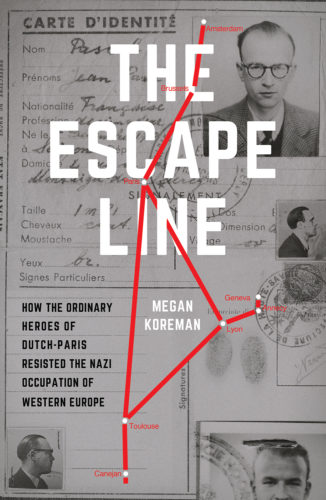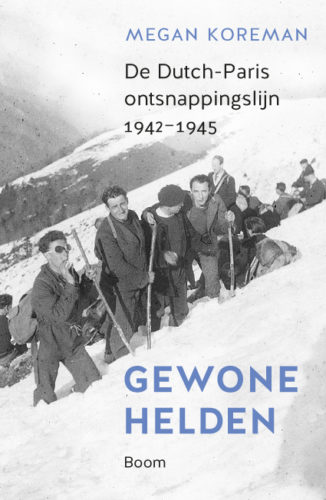Searching for the Dutch-Paris Escape Line
Secrecy and Cooperation among Resisters
Commonsense tells us that resisters worked in isolation. After all, they were up against the Gestapo. All too easily, the opposite of secrecy in the resister’s world became the torture chamber.
So resisters used false names and safe houses. Many of them worked on a cell system in which they knew only the people most closely involved in their own efforts. Only one person in that cell knew only one person in the next cell. That limited the damage that could be done if someone was captured and tortured into revealing information.
This compartmentalization was so important that two young Dutch women who were friends and students together at the Sorbonne in Paris did not know that they both worked for Dutch-Paris in 1943-1944 until Read the rest of this entry »
How Much for a Disguise, False Documents and Train Tickets?
In early March 1944, Weidner asked one of his lieutenants, whom we’ll call Jacques, to take his sister from Paris to Switzerland. Because most of their Dutch-Paris colleagues in Paris had been arrested in the previous few days Jacques had to assume that the police had his description and that every address along the usual route was compromised. So he disguised himself and took the young woman along a more difficult route, known only to him, Weidner and one other colleague.
The news of the arrests that he had to report in Switzerland was so monumental, that Jacques did not bother to describe his own flight from Paris. But he did record his expenses.
Spectacles – 330 French francs
Shower and haircu – 120 French francs
Dry cleaning for his suit – 90 French francs
Timbres fiscaux (official stamps) – 150 French francs
Train tickets to a village on the Swiss border – 1,500 French francs, plus 10 French francs surtax
Tip – 100 French francs
“Gift” – 5,000 French francs
From this we can deduce Read the rest of this entry »
- 0 Comments
- Tags: Border Crossings, women
Rumors of Betrayal and Resistance
Rumors play a vital part in the life of any trapped community whether they are in the trenches of World War I or the resistance of World War II. My last post gave examples of rumors that explained the sweeping arrests in Dutch-Paris in the late winter of 1944. Rumors, however, played a role in the line throughout its existence.
Here’s another example. In October 1943 John Henry Weidner traveled to Paris to create an escape line between the Netherlands and Switzerland. He intended to link up with other Dutch expatriate resisters in Paris. But when he met with a couple of Dutchmen who had been recommended to him as likely colleagues for the illegal undertaking, he found them to be timid and unwilling.
He found out a few days later that the men thought he was a German agent provocateur. They were Read the rest of this entry »
- 0 Comments
- Tags: France, John Henry Weidner
The Rumor of Why
As I said in my last post, resisters needed to know why their colleagues were arrested in order to know if they themselves were in danger. If the resisters knew that their colleague had been arrested for the illegal work they were all doing together, then they wanted to know how the police found their colleague.
With that information they would have a better idea of the extent of the danger and what they could do about it. It was hard, though, to know, and speculation abounded. In the case of the sweeping arrests of Dutch-Paris agents in February, 1944, no one knew for sure how the police found them, but many people had theories.
The Dutch intelligence services in Madrid, for example, suggested that Weidner’s sister had been arrested because Read the rest of this entry »
- 0 Comments
- Tags: arrests
The Cause of Arrest
The arrest of one member of a resistance group obviously caused a great deal of concern for everyone else in the group. They worried about the welfare of their arrested colleague, of course, but they also worried about what that person might be “persuaded” to reveal about the rest of them.
The anxiety was magnified by the fact that you did not necessarily know why a person was arrested. The resisters knew that they had been breaking the law, but the police did not always know it. If someone had been arrested as a suspected resister, then you had reason to fear that he or she would be tortured, but only if the police suspected his or her resistance work.
The German authorities and local police arrested people for so many reasons Read the rest of this entry »
- 0 Comments
- Tags: arrests
Although Dutch-Paris had dependable routes between Brussels, Paris, Lyon, Toulouse and Geneva, Weidner and his top lieutenants did not travel on them. Instead they had their own ways of getting from one place to another. Weidner travelled on the false papers of a businessman, allowing him to take the fastest trains between one city and another. His courier Moen, on the other hand, tacked across France on local trains and climbed along the outside of a bridge stuffed with barbed wire to cross from France to Belgium.
Nor did they stay with other Dutch-Paris resisters in any of the cities they visited. Instead they had their own safe houses, the addresses of which they did not share with anyone.
The leaders made appointments with their colleagues and showed up when Read the rest of this entry »
- 0 Comments
- Tags: John Henry Weidner
Liberated too Late
Almost 70 years ago, on 5 February 1945, Russian soldiers liberated John Weidner’s younger sister Gabrielle from a sub-camp of the notorious women’s concentration camp of Ravensbrück.
On that day, Gabrielle was in what passed as the infirmary, although there was no medicine, no heat, barely any blankets. The only thing that made it an infirmary was that all the prisoners crammed into the building were deathly ill. German guards had already marched the healthier prisoners away toward the west in shoeless, coatless journeys that few would survive. Some of the stronger women in the infirmary crept out to find food despite their well founded fears that the remaining German guards would shoot them on sight.
The prisoners woke up on 5 February to see Russians outside the windows. The Russians did the best they could for the women by making them warm and feeding them. The fighting moved passed them. Gabrielle and some of the other women held a prayer service of thanksgiving. Gabrielle died ten days after her liberation on 15 February 1945 from Read the rest of this entry »
Turned Back at the Border
Dutch-Paris had an elaborate system for smuggling Jews, resisters and other people who needed to get out of the Nazis’ grasp from France to Switzerland. They had a chain of safe houses, many sources of false documents, donors willing to fund the effort and helpers willing to put themselves at risk to escort the fugitives. The sticking point in the escape line was always the Swiss authorities. The men and women of Dutch-Paris broke many laws in occupied France, Belgium and the Netherlands, but in Switzerland they obeyed the law. Their protégés had to have official permission to stay in Switzerland from the Swiss authorities, or they had to return to France.
As a rule, Dutch-Paris did not take anyone over the Swiss border unless they had made arrangements for that person to stay there. This was neither easy nor obvious, but they found ways. On a few occasions, however, the Swiss refused to accept Dutch-Paris fugitives. In June 1943, for example, the courier Moen brought a young Jewish girl Read the rest of this entry »
- 0 Comments
- Tags: Belgium, Border Crossings, Switzerland
A Resister Drafted into the Wehrmacht
I read that the reason books and movies about World War II are so popular is that it was the last time that the moral issues were clear cut, black and white, good vs. evil. In the broad strokes of events, that’s certainly true. But like all generalizations it crumbles with individual exceptions. There is no doubt that epically bad people committed atrocious crimes during the war or that heroically good people fought against them. But the lines are not always so clear cut, especially among young men from the occupied countries.
It was a difficult time to be a young man of military age. The Nazis wanted all able-bodied men working or fighting for the Third Reich. They had some compelling propaganda about saving the world from Bolshevism that convinced some young men to do so willingly. But everyone else had to find a creative way to stay out of German uniform or German factories. Some did not succeed despite hating everything the Nazis stood for.
Take, for example, a young Frenchman who helped Dutch-Paris guide Jewish refugees to the Swiss border. This young man, we’ll call him François, came from the northeastern region of France known as Alsace. It’s a border region that has been fought over by the French and Germans for centuries. In 1940 Hitler declared Read the rest of this entry »
- 0 Comments
- Tags: France
Student Collaborator or Student Resister?
In the last two posts I’ve described the hard choices that two young men made during the war. In both cases, they did what they felt they had to do to protect their families. Here’s another example of a choice that looks compromising from the outside but was actually an act of self-sacrifice to protect the young man’s family.
This story involves a young Dutch resister who had a Jewish father and a Catholic mother. We’ll call him Henk. Henk was a university student when he wasn’t busy searching out hiding places for Jews or sneaking over the border between the Netherlands and Belgium on Dutch-Paris business. In the spring of 1943, however, the German occupation authorities decided that the Dutch university students were causing them an undue amount of difficulties and would be better utilized as factory workers in the Third Reich. They decreed that students had to either sign a loyalty oath or report for labor duty.
The great majority of students, more than 80%, Read the rest of this entry »
- 0 Comments
- Tags: The Netherlands

